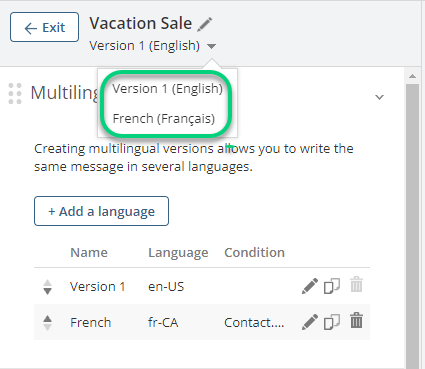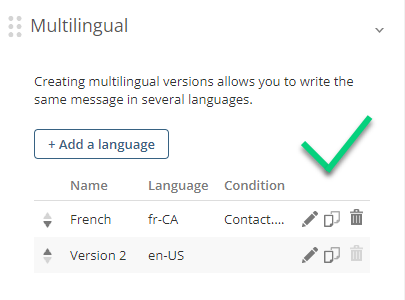It is possible to create an email containing multiple language versions so the language adapts to the recipients depending on their language (if we have that data). For the contacts that we do not know the language, you could have an alternative version (fallback) in the most common language used among your audience.
Prerequisites
- Verify that the languages are activated in the project's configuration.
- Configure project fields to receive data on the contacts' languages.
- Create an email that will be used as the basis for the other versions (possibly in the most used language of your contacts). Ideally, try to integrate all the visual structure (blocks). You can still make changes later when the other versions are created, but you will have to do it manually in each version.
Step 1: Add a Language
Start by adding a new language by clicking Add a language in the Multilingual section:
Fill in the name of the version (recipients will not see that name), choose the language and indicate the project's field that corresponds to the language and the value of the field:
The previous example uses a language field, but you could use another type of field, such as the country or province (this could be useful in a bilingual country like Canada).
| If you want to add more than one condition, select Advanced version under Options. In this interface, you can add several conditions for the same version (e.g., adding a language AND a country). |
Use case example
You are a Canadian company in Toronto. Your basic version is for an English-speaking audience. This version has no condition. You also have a version for contacts who speak French with a language condition for French. Your contacts with a value of French as their language will receive that version. The other contacts who do not meet the French condition will receive the English version by default.
Step 2: Adapt the Content
For each version, you have to change the content manually. Select the version: 
Translate the content in each version, including personalized content. The version will use the tracking links for the selected language.
Step 3: Modify the Priority
In the left section, you have a list of the versions. The system scans the list from the top to the bottom. It first checks the top version to see if contacts meet the conditions for this version, then sends it to these contacts. The system then scans the next line, and so on,
If you have a version containing no conditions (for a general audience), it is recommended that you move it to the end of the list so that it be read at last. This way, your contacts who did not meet the conditions of the other versions' will receive this version as an alternative (fallback).
Using the arrows, move the versions in the order you want them to be processed:


**The first created version cannot be deleted. If you want to disable it, you can move it to the end of the list after a version without a condition or give this version a condition impossible to meet.
For additional versions, you can copy an existing version as a starting point by clicking on  .
.
Step 4: Test the Versions
Go to the Test interface to simulate sendings for the different versions (one by one):
For more information, see the article on email tests.
Duplicating a Multilingual Email
You can make a copy of an email, including its versions (or not), to use it as a starting point for another email.
Go to the list of emails and click on Duplicate:

